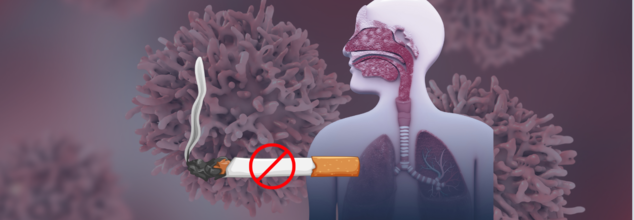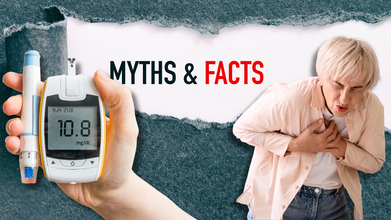- Health Conditions A-Z
- Health & Wellness
- Nutrition
- Fitness
- Health News
- Ayurveda
- Videos
- Medicine A-Z
- Parenting
- Web Stories
If You’ve Never Smoked, Why Are You At Risk For Lung Cancer?

Lung cancer is usually blamed on smoking, but a significant number of instances occur in non-smokers who have never seen the inside of a cigarette package. The American Cancer Society says that about 20% of lung cancer deaths occur in non-smokers. This leads us to ask: why are these non-smokers getting lung cancer, and why are they at risk?
Though smoking is still the primary cause of lung cancer, studies indicate that environmental, genetic, and occupational factors combined are also responsible for the development of the disease. The MD Anderson Cancer Center and other research facilities throughout the U.S. have been conducting intensive research into why lung cancer affects non-smokers and how the disease differs from smoking-induced cancer.
The majority of lung cancers that are diagnosed in never-smokers are non-small cell lung cancers (NSCLC), accounting for approximately 85% of all lung cancers. Of these, adenocarcinoma is the most frequent subtype among non-smokers. Scientists have found that close to 30% of NSCLC occurrences among non-smokers are caused by genetic mutations, which can be treated with targeted therapies.
Key Genetic Factors in Non-Smoker Lung Cancer Cases
Lung cancer in people who have never smoked is typically associated with particular genetic mutations. Two of the most important biomarkers are:
EGFR mutations: EGFR mutations account for approximately 10-15% of lung cancer in the U.S. and are more frequently found in non-smokers, especially in females and Asian patients.
ALK gene rearrangements: This mutation is found in approximately 5% of lung cancers and can be treated with certain drugs that inhibit the activity of the abnormal protein.
These genetic determinants suggest that non-smoker lung cancer patients could be more responsive to targeted therapies, bringing new hope to treatment possibilities.
Environmental and Occupational Risk Factors
Even though one does not smoke, most are exposed to substances that cause lung cancer. There are various environmental and occupational causes that have been discovered:
Radon Exposure
Radon is a naturally occurring radioactive gas that emanates from the ground and can build up in houses, particularly in basements and poorly ventilated areas. The U.S. Environmental Protection Agency (EPA) estimates that radon exposure leads to approximately 3,000 lung cancer deaths each year. Research has established a strong link between elevated radon levels and lung cancer among non-smokers.
Why is Secondhand Smoke A Significant Threat?
Even for someone who never smoked, years of exposure to secondhand smoke greatly raises lung cancer risk. According to the Centers for Disease Control and Prevention (CDC), there are an estimated 7,000 deaths from lung cancer every year due to secondhand smoke. Smokers' partners, family members, and colleagues are particularly susceptible to breathing in dangerous chemicals from cigarette smoke.
Air Pollution and Industrial Toxins
Long-term exposure to air pollution, such as vehicle exhaust and industrial emissions, has been associated with a higher risk of lung cancer. A 2013 report by the International Agency for Research on Cancer (IARC) identified outdoor air pollution as a carcinogen, highlighting the contribution of fine particulate matter (PM2.5) to lung cancer.
Exposure to these substances in the workplace, such as asbestos, arsenic, and diesel exhaust, also puts one at greater risk. People who work in construction, manufacturing, and mining are especially susceptible to inhaling these cancer-causing particles.
Family History and Genetic Susceptibility
Family history of lung cancer in non-smokers also places them at greater risk, with a possible genetic component. In case a first-degree relative (parent, sibling, or child) has developed lung cancer, especially at a younger age, the risk factor for developing the disease is elevated. This also points to inherited genetic mutations potentially making some individuals more vulnerable to lung cancer.
Identifying Symptoms
Symptoms of lung cancer are usually mild and may be confused with other illnesses, so it is frequently diagnosed late in the majority of instances. The usual symptoms are:
- Chronic cough or increasing cough over time
- Sputum containing blood
- Chest discomfort or pain
- Shortness of breath or difficulty breathing
- Wheezing
- Weight loss without an obvious cause
- Weakness
- Hoarseness or swallowing difficulty
- Recurrent infections of the lungs
Since non-smokers usually do not see themselves as being at risk for lung cancer, they might postpone medical care until the disease advances to a severe stage before being diagnosed.
Can You Lower Your Risk of Lung Cancer?
Though some risk factors, like heredity, cannot be modified, there are a number of proactive measures that you can do to reduce your risk of lung cancer. One of the most significant steps is to have your home tested for radon, as the Environmental Protection Agency (EPA) highly recommends, particularly in high-radon areas. Long-term exposure to this odorless gas can cause a high risk of lung cancer, and early detection is vital. Also, staying away from secondhand smoke is crucial. If you reside with a smoker, persuading them to quit or having proper ventilation to reduce exposure can safeguard your lungs. Lessening exposure to toxic pollutants is another crucial step—sitting indoors with air purifiers and using protective masks while working in risk-prone places can reduce the inhalation of harmful chemicals.
Lastly, a healthy way of life plays an important part in lung health. A healthy diet of fruits and vegetables, exercise regularly, and refraining from known carcinogens can make your immune system strong and help lung function in general. Using all these preventive steps can contribute significantly to lowering the risk of lung cancer and improving respiratory health. Who is Eligible for Lung Cancer Screening?
Today the U.S. Preventive Services Task Force screens for lung cancer only in individuals with a smoking history. What this implies is that non-smokers are usually not screened, except when there are symptoms or other risk indicators. There is an argument though that those who have a large family history and high exposure to radon are also worth early screening.
Lung cancer is not solely a disease of smokers. With increasing incidence in non-smokers, it's essential to know about different risk factors and take preventive action wherever feasible. If you have persistent symptoms, see your doctor to eliminate any possible serious conditions. Early detection is the strongest defense against lung cancer, irrespective of smoking status.
Magnesium For Sleep: Do These Popular Supplements Really Work or Pose Hidden Risks?

Credits: Canva
If you often find yourself tossing in bed or staring at the ceiling at 3 a.m., you might be wondering whether magnesium, the mineral known for promoting calm and relaxation, could be the key to better sleep. It may be worth exploring, especially if your body lacks enough of it, says Denise M. Millstine, M.D., assistant professor of medicine and director of integrative medicine and health at Mayo Clinic in Arizona.
Those most at risk of magnesium deficiency include women, older adults, people who drink alcohol regularly, and anyone whose diet relies heavily on processed or convenience foods.
So, does magnesium truly live up to the hype? It’s certainly trending. According to Growth Market Reports, sales of topical magnesium products reached $421.6 million in 2023, while Grand View Research valued the magnesium supplement market at $29.3 million in 2024.
What Are Magnesium Supplements?
Magnesium supports over 300 essential body functions and plays a major role in healthy aging. Still, the belief that it can be a hidden cure-all deserves a closer look. To separate science from speculation, let’s examine two widely circulated claims on social media: that magnesium guarantees better sleep, and that it can ease anxiety or depression.
How Magnesium May Help With Sleep
Magnesium helps regulate several processes in the body, including the balance of neurotransmitters, the chemicals that allow nerve cells to communicate, Dr Millstine explains. These messengers influence mood, sleep, memory, and muscle control.
“Some neurotransmitters stimulate, while others calm,” she says. “Magnesium helps maintain balance between the two.” If you struggle with anxiety or racing thoughts at bedtime, magnesium might help tilt the scale toward the calming side, making it easier to drift off.
Dr Millstine adds that people with “busy minds” may notice the most improvement. “Some individuals can suppress their anxious thoughts during the day, but when night falls, their minds grow louder and harder to quiet,” she explains.
Can Taking Magnesium Have Side Effects?
Experts do not advise magnesium supplements for people who aren’t deficient in the mineral.
While generally safe, it’s best to consult a doctor before adding magnesium to your routine, especially if you have existing health issues. The supplement may not be suitable for those taking certain diuretics, antibiotics, or heart medications.
Most users experience no side effects, though high doses can lead to digestive problems. Possible reactions include:
- Diarrhea
- Nausea
- Vomiting
People with kidney problems are more vulnerable to magnesium toxicity, as their bodies may struggle to clear excess amounts.
How Much Magnesium Should You Take?
The ideal magnesium dosage ranges between 200 and 400 mg daily, depending on the product. This typically provides the full recommended daily intake.
According to Healthline, the safe upper limit for magnesium supplements is 350 mg per day. Staying within this range helps reduce the risk of digestive discomfort and other side effects.
This article is intended for general informational purposes only and should not be taken as medical advice. Always consult your doctor or a qualified healthcare professional before starting any supplement or treatment.
'Don't Continue Medication If You're Better' Neurologist Busts 10 Common Health Misconceptions

(Credit-Canva)
In a recent post, Dr Sudhir Kumar busted 10 common misconceptions people have about health. Health misconceptions occur very often, while you may not realize it; we also perpetuate these myths very often.
To help people avoid these, Dr Sudhir Kumar, a Hyderabad-based Neurologist, listed misconceptions about common diseases. The reason why it is important to know what to believe and what not to, is because these myths can lead people to ignore obvious health signs, like signs of heart attacks, because they believe they are unlikely to get one themselves.
10 Health Myths You Should Not Believe
Here are 10 common health misconceptions you should know about, according to Dr Sudhir Kumar.
Myth: Stroke Only Happens to the Elderly.
Fact: Stroke Can Happen at Any Age. Many people think strokes are just an old-age problem, but this is false. Strokes can strike young adults, even in their 30s or 40s. Having high blood pressure, diabetes, or smoking greatly increases the risk, regardless of your age. Staying healthy is crucial for everyone.
Myth: Heart Attacks Always Cause Severe Chest Pain.
Fact: Heart Attacks Can Be Silent or Mild. It’s a common belief that a heart attack is always a sudden, crushing pain. However, many heart attacks are mild or "silent," causing only slight discomfort or unusual fatigue. This is especially common in women and people with diabetes, making it easy to overlook.
Myth: Fever Must Always Be Brought Down Quickly.
Fact: Fever is Your Body's Natural Defense. Fever is how your immune system fights off infections. You only need to treat it if the temperature is dangerously high or if you feel very uncomfortable. For mild fevers, let your body do its job; focus on rest and hydration instead.
Myth: Antibiotics Cure Colds and Flu.
Fact: Antibiotics Only Fight Bacteria, Not Viruses. Colds and the flu are caused by viruses, and antibiotics are useless against them. Taking antibiotics unnecessarily will not help and actually makes them less effective against real bacterial infections later on. Only use them when prescribed for bacteria.
Myth: High Blood Pressure Always Causes Symptoms.
Fact: Hypertension is Usually a Silent Condition. High blood pressure (hypertension) is often called the "silent killer" because it rarely causes noticeable symptoms until it's very severe. This is why getting your blood pressure checked regularly is essential. You need routine checks to catch it early before it causes damage.
Myth: Eating Sweets Causes Diabetes.
Fact: Diabetes is Complex, Not Just Caused by Sugar. While eating too much sugar makes Type 2 diabetes worse, the disease is primarily caused by a mix of genetics, not exercising enough, and the body's inability to properly use insulin (insulin resistance). It is a lifestyle disorder, not just a sugar problem.
Myth: Sunscreen is Only Needed on Sunny Days.
Fact: Harmful UV Rays Get Through Clouds Daily. Many people skip sunscreen on cloudy or overcast days, but this is a mistake. Ultraviolet (UV) rays from the sun, which damage your skin, can easily penetrate clouds. You need to apply sunscreen every single day for proper protection against skin aging and cancer.
Myth: Cancer Always Runs in Families.
Fact: Lifestyle and Environment Cause Most Cancers. While certain rare cancers are linked to inherited genes, the majority of cancer cases are actually caused by daily habits and environmental factors. Things like smoking, diet, lack of exercise, and sun exposure play a much bigger role in cancer risk for most people.
Myth: Once Symptoms Improve, You Can Stop Taking Medicines.
Fact: Stopping Treatment Early Can Cause Relapse. You must always finish the full course of medicine as directed by your doctor. Stopping treatment too soon—especially antibiotics or blood pressure medication—allows the illness to come back or get worse. Follow the prescription to fully clear the infection or manage the condition.
Myth: Mental Health Problems Mean Weakness.
Fact: Mental Health Issues Are Real Medical Conditions. Conditions like depression or anxiety are genuine medical illnesses, just like diabetes or heart disease. They are not a sign that a person is weak or failing. Seeking help from a professional shows courage and strength, taking an active step toward recovery and well-being.
5 Things People In Their 20s Should Know To Support Hormonal Health, According To Gynecologist

(Credit-Canva)
Your hormonal health plays a huge role in your health, and if you think it is something you need to worry about only when you get older. However, that is not true; you must pay attention to it even if you are in your 20s. Dr Holly Miller, an American Board–certified obstetrician and gynecologists, shared a video explaining why it is important for youngsters to regulate their hormonal health.
Your twenties are a critical time for building the foundation of your long-term health, impacting everything from your fertility and metabolism to your overall well-being. Hormone balance is about more than just your menstrual cycle, it profoundly influences your skin, mood, energy levels, and even your long-term risk for conditions like PCOS or endometriosis.
5 Ways To Maintain Your Hormonal Health
Here are five evidence-based strategies to actively support your hormone health
Prioritize Deep, Consistent Sleep
Sleep is the time when your body performs essential repair and resets your hormonal systems. When you consistently get 7 to 9 hours of quality sleep, you stabilize cortisol, your main stress hormone.
High cortisol from lack of sleep throws off the production of reproductive hormones like estrogen and progesterone, which can lead to irregular cycles and worsen PMS. Think of a good night's sleep as the number one way to calm your internal chemistry and support the natural rhythm your hormones need to thrive.
Balance Your Blood Sugar
Rapid spikes in blood sugar trigger a rush of the hormone insulin to bring the sugar down. Over time, these frequent spikes lead to insulin resistance, a major driver of hormonal imbalances like PCOS. The key is to slow down sugar absorption.
When you eat carbohydrates like bread or fruit, always pair them with protein like eggs or chicken and healthy fat like avocado or nuts. This simple habit keeps your insulin levels steady and prevents the hormonal chaos caused by rollercoaster blood sugar.
Minimize Endocrine Disruptors
Endocrine-disrupting chemicals (EDCs) are hidden in many everyday products, from the lining of food cans (BPA) to synthetic fragrances and certain plastics. These chemicals are problematic because they can mimic or block your natural hormones, especially estrogen.
This interference can confuse your body, leading to heavy periods, unpredictable cycles, or fertility issues. Start simple: switch to using glass water bottles and food storage, choose fragrance-free products, and look for "paraben-free" labels on your skincare and makeup.
Engage in Regular Movement
Movement isn't just for weight loss, it is powerful hormonal medicine. Exercise, especially resistance training (lifting weights or using body weight), makes your cells much more responsive to insulin.
This means your body can process sugar more efficiently, which is vital for balancing all other hormones. Additionally, regular movement helps reduce body-wide inflammation, which is a primary cause of painful, uncomfortable period symptoms. Aim for a mix of strength training and light cardio throughout your week.
Fuel Up on Key Nutrients
Your hormones require specific building blocks and helpers to function optimally. Three critical nutrients are: Omega-3s, which are found in fatty fish/flaxseed, that reduce inflammation to ease cramps and mood swings.
Vitamin D, which acts more like a hormone itself and plays a role in regulating the menstrual cycle; and Magnesium, known as "nature's relaxant," which helps reduce PMS-related anxiety, migraines, and cramps. Focus on incorporating these vital fats and minerals into your diet every day to directly support better hormonal health.
© 2024 Bennett, Coleman & Company Limited

